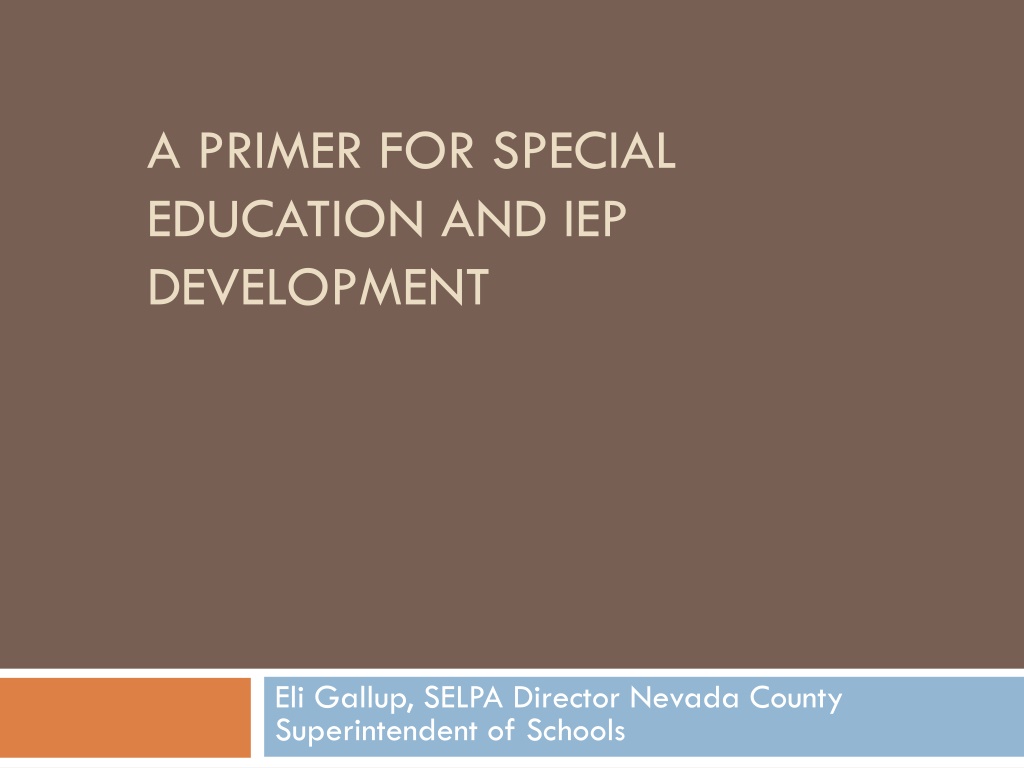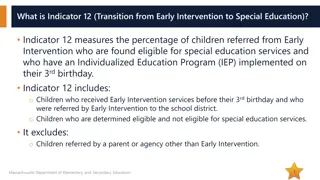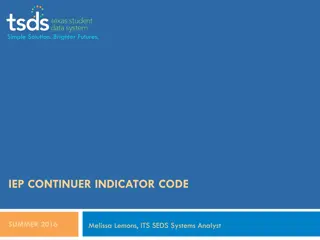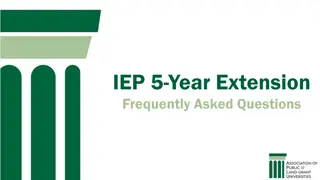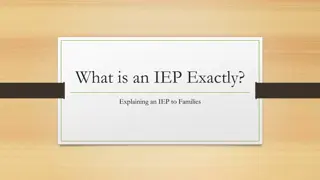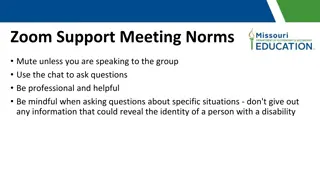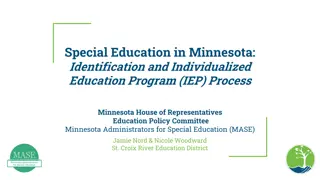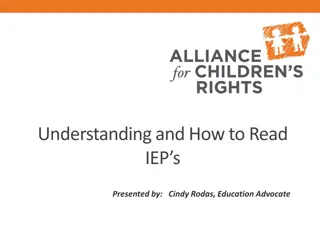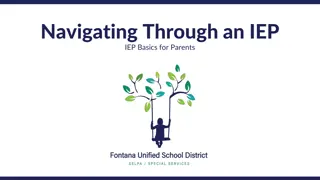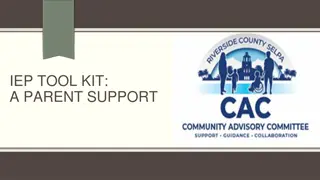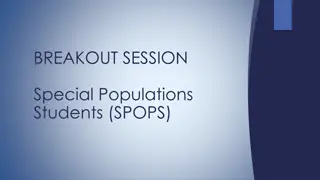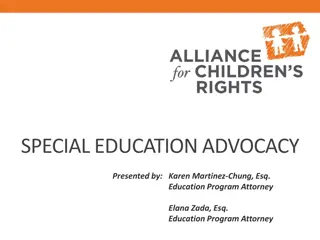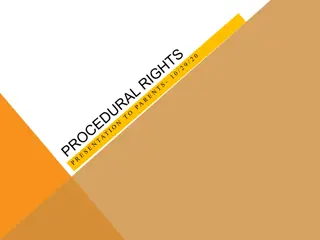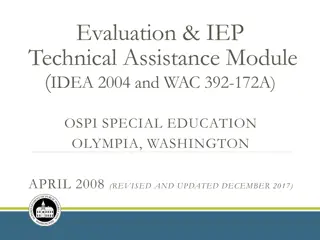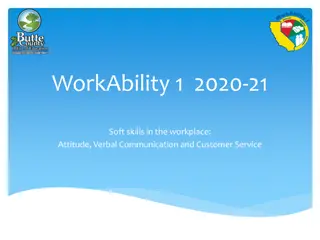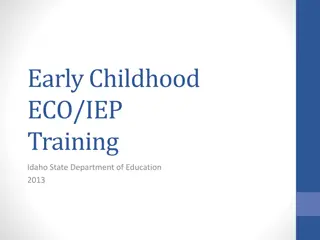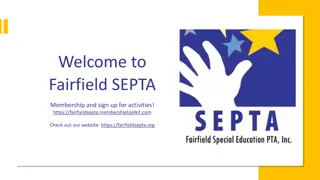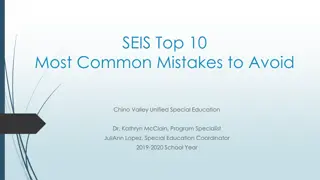Understanding Special Education and IEP Development
Explore the key concepts of special education, including FAPE and the IEP process under IDEA 2004. Learn about the Least Restrictive Environment and how it ensures that students with disabilities receive appropriate education tailored to their needs while promoting inclusion. Discover the importance of setting high expectations for all students to prepare them for success in education, employment, and independent living.
Download Presentation

Please find below an Image/Link to download the presentation.
The content on the website is provided AS IS for your information and personal use only. It may not be sold, licensed, or shared on other websites without obtaining consent from the author. Download presentation by click this link. If you encounter any issues during the download, it is possible that the publisher has removed the file from their server.
E N D
Presentation Transcript
A PRIMER FOR SPECIAL EDUCATION AND IEP DEVELOPMENT Eli Gallup, SELPA Director Nevada County Superintendent of Schools
Agenda/Goals Familiarize you with IDEA (Individuals with Disabilities Education Act) The Educational Continuum Special Education Eligibility, FAPE and the IEP Process
INDIVIDUALS WITH DISABILITIES ACT (IDEA) 2004 3 Students with disabilities have a right to a Free Appropriate Public Education (FAPE) . In the Least Restrictive Environment (LRE) As described in the IEP designed to provide educational benefit
WHAT IS FAPE? 4 Free and Appropriate Public Education Federal Regulations delineate that special education should Ensure access of the child to the general curriculum, so that the child can meet the educational standards within the jurisdiction of the public agency that apply to all children 34 CFR 300.39(b)(3)(ii)
WHAT IS FAPE CONTD.? 5 IDEA 2004 sets higher standard for FAPE: High expectations for all students Be prepared to lead productive and independent adult lives, to the maximum extent possible Prepare students for further education, employment, and independent living
WHAT IS LEAST RESTRICTIVE ENVIRONMENT (LRE)? 6 To the maximum extent appropriate, children with disabilities are educated with children who are not disabled Special classes, separate schooling, or other removal from the regular educational environment occurs only if the nature or severity of the disability is such that education in regular classes with the use of supplementary aids and services cannot be achieved satisfactorily 34 CFR Section 300.114
Key Concepts of LRE The general education class is always the first choice considered Applies to all children with disabilities Must be individually determined and based on a student s individual needs Consideration and use of supplementary aids and services to make the general education class a first and viable choice is required
WHAT IS EDUCATIONAL BENEFIT? 8 Based on the legislative history (Rowley Decision) and IDEA s definitions of FAPE, special education, and related services, the U.S. Supreme Court concluded that the IDEA does not require that States maximize the potential of students with disabilities, but must be reasonably calculated to provide educational benefit to enable the child with a disability to achieve passing marks and advance from grade to grade.
WHAT IS REASONABLY CALCULATED? 10 Based on procedural requirements, including: 1) The assessment is complete and the child is assessed in all areas of suspected disability 2) The IEP team identifies needs related to: the child s disability involvement and progress in the general curriculum 3) Goals are established in each need area Benchmarks are developed for students taking CAPA
REASONABLY CALCULATED CONT D. 11 4) Services are planned to support: Progress towards all goals Progress in the general curriculum Participation in the regular education environment Education with other students with disabilities and typically developing peers
REASONABLY CALCULATED CONT D. 12 Program should be reasonably calculated to result in educational benefit as measured by: Achieving passing marks Advancing from grade to grade Making progress toward meeting goals and objectives Improved scores on statewide or district wide tests and/or alternate assessment measures Passing the CAHSEE Graduating with a diploma
ROWLEY STANDARD..AN APPROPRIATE IEP IS ONE THAT 13 Is calculated to provide educational benefit, according to the student s individual needs as assessed at the time the offer of FAPE is made Is likely to produce more than trivial educational advancement No requirement to maximize student s abilities, or what a parent might choose as an optimum program or service Does not rely solely on grade advancement as a measure of progress; and Places the student in the LRE, even if superior educational benefit might result from a more restrictive placement
What is Special Education? Specially designed instruction, at no cost to the parents, to meet the unique needs of a child with a disability. Special Education is a service, not a place
Educational Continuum IDEA Section 300.114(a)(2)(i) and Section 300-115(a) tell us: To the maximum extent appropriate, children with disabilities are educated with children who are not disabled. Each public agency shall ensure that a continuum of alternative services placement is available.
Who is eligible? Between the ages of 3 22 Two Pronged Test: 1. with a disability 2. Meets the definition of an individual Disability must: - adversely affect educational performance - require special education
Special Education Categories Autism Deaf Deaf Blind Emotionally Disturbed Hard of Hearing Mental Retardation Multi-handicapped Visually Handicapped Orthopedically Handicapped Other Health Impaired Specific Learning Disability Speech Impaired Traumatic Brain Injury
The IEP includes: Present level of functioning Measurable annual goals and short term objectives Statement of specific modifications, accommodations, special education services, related services, supplementary aids and services to be provided Explanation of the extent to which the student will participate in general education Statement regarding participation in State and District wide assessments Projected date for beginning services Evaluation procedures for measuring progress on goals and objectives.
IEP components continued: Statement of how child s parents will be regularly informed of progress Prevocational/employment/ career education goals, if appropriate Alternative criteria for promotion Graduation, if appropriate A plan for transition into general education Specialized services and equipment, if appropriate Transportation needs Goals for learning English, for students identified as English Language Learners Extended school year, if appropriate (Education Code 56345)
Present Levels of Performance (PLOP) 20 Include results of state, district-wide, and individual assessments Narrative should reflect the student s classroom performance Address all areas with present levels Indicate age appropriate or no concerns noted at this time as applicable
21 IEP IEP GOALS & GOALS & OBJECTIVES OBJECTIVES
IEP GOAL REQUIREMENTS 22 A statement of measurable annual goals, including academic and functional goals, designed to: (A) Meet the needs of the individual that result from the disability of the individual to enable the pupil to be involved in and make progress in the gen. ed. curriculum (B) Meet the other educational needs of the pupil that result from the disability of the individual. Other Requirements: How progress towards IEP goals will be reported Periodic reports on the progress concurrent with report cards E. C. 56345
WRITING GOALS ENSURE EDUCATIONAL BENEFIT 23 Goals must be measurable Goals should be aligned to state standards - prerequisite goals may be needed Goals may address other educational needs such as functional skills, etc.
MEASURABLE GOALS 7 Key Components Baseline (must be related to the goal) Who (the child) Does what (measurable behavior) When (reporting date) Given what (conditions) How much (mastery criteria-how much, how often) How measured (performance data or assessment) 24
SPECIAL EDUCATION & RELATED SERVICES 25
Supplementary Aids and Services Aids, services, and other supports that are provided in general education classes or other education- related settings to enable children with disabilities to be educated with non-disabled children to the maximum extent appropriate in accordance with 300.550-300.556. (Authority: 20 U.S.C. 1401(29))
BEST PRACTICES FOR CONSIDERATION OF SPECIAL EDUCATION & RELATED SERVICES The determination of appropriate services should be completed after goals have been proposed. Special education, related services, and supplementary aids and services should be based on peer-reviewed research to the extent practicable. 28
Service Continuum General Education Class General Education Class with services/aides General Education class with RSP Class (push in or pull out) Special day class/general education Special day class/RSP Special day class
Service Continuum Part day & home instruction Isolated sites Non-public school Residential/non-public school Home Instruction
Designated Instructional Services Speech/language Orientation/mobility Transportation Adaptive PE Occupational therapy Physical therapy Assistive technology Interpreters Counseling Behavior Educationally Related Mental Health Services Health and nursing services
PARENTS MEANINGFUL PARTICIPATION IN THE IEP So What Is Meaningful Parent Input to the IEP and how is it documented? 32
A Parent Has Meaningfully Participated When . He/she participated in the development of the IEP; He/she was informed of concerns about their child; He/she attended the IEP meeting; He/she requests revisions to the IEP; and He/she expressed their disagreement or agreement regarding IEP conclusions. (N.L. v. Knox County Schools (6th Cir. 2003) 315 F.3d 688.) 33
Encouraging Meaningful Parent/Guardian IEP Participation Present notice of procedural safeguards and ask parents if they have any questions. Ask for parental input throughout IEP meeting. Listen! Allow parents the opportunity to voice their opinions, even if they disagree with district. After reviewing any information, ask parents if they have any questions. Ask parents to share their opinions about required IEP topics, i.e., progress toward goals, proposed goals, placement options, etc. IEP team must review/consider reports provided by parents. 34
Review and Revision of the IEP Must be periodic, at least annually To determine whether goals are being achieved To address Lack of expected progress Results of any re-evaluation Information from parents Child s anticipated needs, or Other
A Final Thought Students with special needs are general education students who require specialized instruction As a team, we can work together for each student s success
Source Information Sources include, but are not limited to: California Department of Education Jarice Butterfield & Claudia Echavarria, developers of, Conducting & Writing Best Practice IEP s Rusty Gordon, developer of Special Education 101-A Brief Primer for Substitute Teachers Special Education Local Plan Administrators of California
